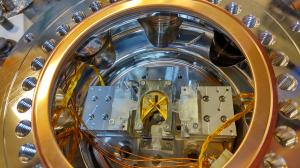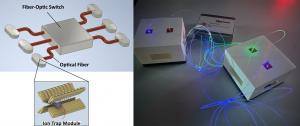Qubitcore™, an OIST Spin‑Out, Raises Pre‑Seed Funding to Advance Japan’s Ion‑Trap Quantum Computers
New capital accelerates Qubitcore’s ion‑trap architecture and photonic links for fault‑tolerant distributed quantum computing.
This pre-seed funding lets us build on distributed ion-trap prototypes toward a scalable platform for fault-tolerant quantum computing with real-world impact.”
YOKOHAMA, KANAGAWA, JAPAN, July 16, 2025 /EINPresswire.com/ -- Qubitcore Inc. (Founder & CEO: Ryuta Watanuki), the Okinawa Institute of Science and Technology Graduate University (OIST; President & CEO: Karin Markides), and Lifetime Ventures (Founder & General Partner: Ryosuke Kimura) today announced the closing of Qubitcore’s pre-seed funding round, led by the OIST Lifetime Ventures Fund.— Ryuta Watanuki, Founder & CEO, Qubitcore Inc.
In parallel, Qubitcore has signed an exclusive licensing agreement with OIST, granting the startup access to foundational intellectual property from OIST’s Experimental Quantum Information Physics Unit. Together, these developments mark a major step toward realizing scalable, fault-tolerant quantum computers (FTQCs) through a distributed quantum computing (DQC) architecture built on OIST-developed ion-trap modules with integrated optical cavities, interconnected via photonic links.
QUBITCORE’S TECHNOLOGY: DISTRIBUTED QUANTUM COMPUTING ARCHITECTURE
Qubitcore’s distributed architecture overcomes the scalability limitations of conventional quantum processing units (QPUs—the processors that perform quantum calculations) by combining ion-trap modules integrated with optical cavities (resonant structures that trap light to enable efficient ion–photon interaction) and a photonic interconnect network. This enables high-speed, high-fidelity remote entanglement [1] between modules—offering a breakthrough toward scalable distributed quantum computing.
By maximizing the performance of individual QPUs while optically connecting them, Qubitcore aims to build large-scale systems previously difficult to realize using conventional ion-trap methods—ultimately paving the way toward practical fault-tolerant quantum computers (FTQCs). The licensed technologies originated from the Experimental Quantum Information Physics Unit at OIST, led by Assistant Professor Hiroki Takahashi. He also serves as the project manager for the Cabinet Office’s Moonshot R&D Goal 6 initiative: “Realization of a fault-tolerant universal quantum computer that will dramatically advance economy, industry, and security by 2050.” Some of the unit’s research has been supported by OIST Innovation through the Proof of Concept (PoC) program. Qubitcore builds on these achievements to accelerate the transition from fundamental research to real-world quantum systems.
FUNDING AND FUTURE DEVELOPMENT
Qubitcore has secured pre-seed funding from the OIST Lifetime Ventures Fund: The capital will be used to accelerate the early-stage development of hardware systems, with a focus on the procurement of experimental equipment, prototyping of ion-trap modules with integrated optical cavities, and recruitment of dedicated research personnel.
To support its early-stage development, Qubitcore plans to combine equity financing with non-dilutive sources, including potential public grants from programs such as NEDO.
Looking ahead, Qubitcore aims to establish the technical and organizational foundations necessary for future commercialization, with a focus on scalable, fault-tolerant quantum architectures. The company has also outlined a multi-phase roadmap toward full-scale FTQC deployment:
– In 2028, it plans to unveil a first-generation testbed system for experimental quantum error correction.
– In 2029, it plans to demonstrate a second-generation prototype that will showcase photonic interconnects between modules, suggesting architectural potential for future expansion toward 1,000-qubit-class systems [2].
– By 2030, Qubitcore targets commercial-grade deployment based on this architecture.
These milestones will be supported by focused R&D efforts in modular ion-trap integration, experimental validation of photonic links, and high-efficiency quantum error correction. The company also plans to initiate early-stage development of a control platform for future quantum computing services.
STATEMENTS FROM KEY STAKEHOLDERS
Ryuta Watanuki, Founder & CEO, Qubitcore Inc.
“We are honored to join the community of OIST-originated startups and to receive support from Lifetime Ventures. This milestone represents a significant step toward commercializing Japan’s first domestically developed ion-trap quantum computer. Building on the research achievements of the Takahashi Unit at OIST, we aim to accelerate the real-world deployment of our distributed quantum computing system and drive social impact by translating cutting-edge research into practical applications. As we advance our technology with industrial use cases in mind, we are committed to embedding quantum computing into the fabric of society.”
Hiroki Takahashi, Co-Founder & CSO, Qubitcore Inc. / Assistant Professor, OIST
“It is deeply meaningful to see research on quantum photonic interconnects using ion traps, which we have pursued at OIST, evolve into concrete initiatives for social implementation. I look forward to rapid advancements in research and development, driven by collaboration between OIST, Qubitcore, and researchers both in Japan and abroad.”
Ryosuke Kimura, General Partner, Lifetime Ventures
“Japan has built decades of foundational expertise in photonics and ion-trap technologies, and in recent years, this has been further accelerated by significant national support—most notably through Moonshot Goal 6, which allocates a total of JPY 148 billion (approximately USD 1.0 billion) to advance fault-tolerant universal quantum computers [3]. Within this ecosystem, OIST provides a world-class experimental environment under a fully English and internationally integrated research structure. It is from this context that Qubitcore was founded—by a team of ion-trap researchers from both Japan and Europe. I firmly believe this fusion of national policy, global talent, and deep technical heritage marks the beginning of a quantum hardware platform from Japan with the potential for global impact.”
About Qubitcore Inc.
Qubitcore Inc. is a startup founded to bring into practical use the research outcomes of the Experimental Quantum Information Physics Unit, led by Associate Professor Hiroki Takahashi at the Okinawa Institute of Science and Technology (OIST). The company is developing a distributed quantum computing architecture that integrates ion-trap technology with photonic quantum networks, aiming to realize fault-tolerant quantum computers (FTQCs). Qubitcore is headquartered in Yokohama, Kanagawa Prefecture, with its R&D center located within OIST in Okinawa.
NOTES TO EDITORS
[1] Remote Entanglement: A quantum mechanical effect where qubits located in separate modules are linked via photonic channels. Measuring one instantly determines the state of the other—a foundational capability for distributed quantum computing (DQC).
[2] Qubit: The basic unit of quantum information. Unlike classical bits, qubits can exist in a superposition of 0 and 1 before measurement.
[3] Cabinet Office, Government of Japan – Council for Science, Technology and Innovation
“Moonshot R&D Program – Progress Report” (May 15, 2024)
PDF: https://www8.cao.go.jp/cstp/moonshot/kaigi/20240515/siryo2.pdf (see page 14)”
Ryuta Watanuki
Qubitcore Inc.
email us here
Visit us on social media:
LinkedIn
X
Facebook
Legal Disclaimer:
EIN Presswire provides this news content "as is" without warranty of any kind. We do not accept any responsibility or liability for the accuracy, content, images, videos, licenses, completeness, legality, or reliability of the information contained in this article. If you have any complaints or copyright issues related to this article, kindly contact the author above.



